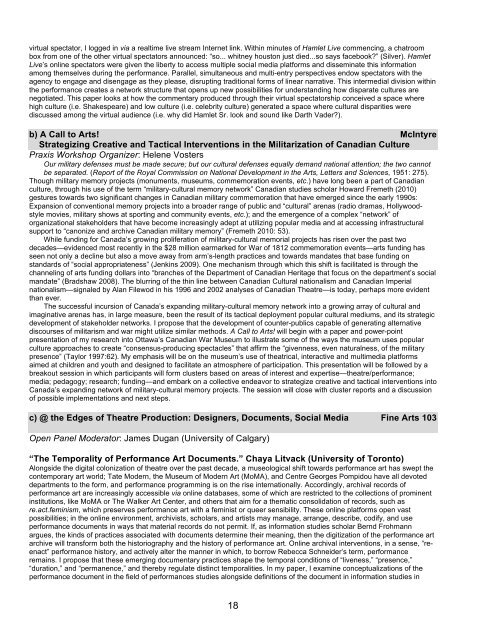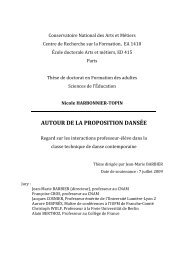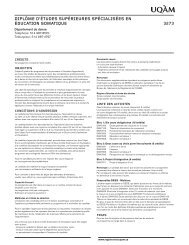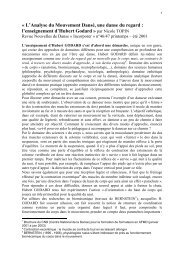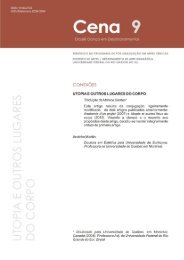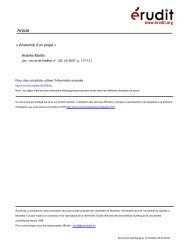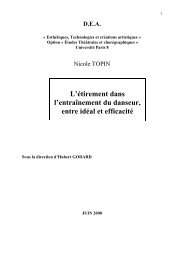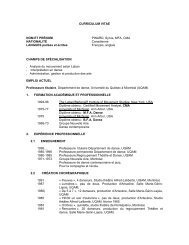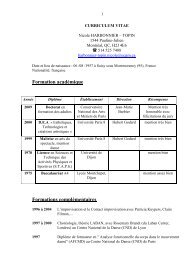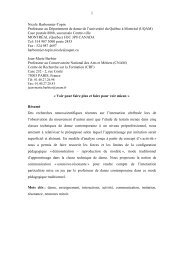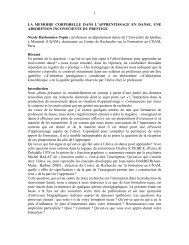Day 2 - Département de danse - UQAM
Day 2 - Département de danse - UQAM
Day 2 - Département de danse - UQAM
You also want an ePaper? Increase the reach of your titles
YUMPU automatically turns print PDFs into web optimized ePapers that Google loves.
virtual spectator, I logged in via a realtime live stream Internet link. Within minutes of Hamlet Live commencing, a chatroom<br />
box from one of the other virtual spectators announced: “so... whitney houston just died...so says facebook?” (Silver). Hamlet<br />
Live’s online spectators were given the liberty to access multiple social media platforms and disseminate this information<br />
among themselves during the performance. Parallel, simultaneous and multi-entry perspectives endow spectators with the<br />
agency to engage and disengage as they please, disrupting traditional forms of linear narrative. This intermedial division within<br />
the performance creates a network structure that opens up new possibilities for un<strong>de</strong>rstanding how disparate cultures are<br />
negotiated. This paper looks at how the commentary produced through their virtual spectatorship conceived a space where<br />
high culture (i.e. Shakespeare) and low culture (i.e. celebrity culture) generated a space where cultural disparities were<br />
discussed among the virtual audience (i.e. why did Hamlet Sr. look and sound like Darth Va<strong>de</strong>r?).<br />
b) A Call to Arts! McIntyre<br />
Strategizing Creative and Tactical Interventions in the Militarization of Canadian Culture<br />
Praxis Workshop Organizer: Helene Vosters<br />
Our military <strong>de</strong>fenses must be ma<strong>de</strong> secure; but our cultural <strong>de</strong>fenses equally <strong>de</strong>mand national attention; the two cannot<br />
be separated. (Report of the Royal Commission on National Development in the Arts, Letters and Sciences, 1951: 275).<br />
Though military memory projects (monuments, museums, commemoration events, etc.) have long been a part of Canadian<br />
culture, through his use of the term “military-cultural memory network” Canadian studies scholar Howard Fremeth (2010)<br />
gestures towards two significant changes in Canadian military commemoration that have emerged since the early 1990s:<br />
Expansion of conventional memory projects into a broa<strong>de</strong>r range of public and “cultural” arenas (radio dramas, Hollywoodstyle<br />
movies, military shows at sporting and community events, etc.); and the emergence of a complex “network” of<br />
organizational stakehol<strong>de</strong>rs that have become increasingly a<strong>de</strong>pt at utilizing popular media and at accessing infrastructural<br />
support to “canonize and archive Canadian military memory” (Fremeth 2010: 53).<br />
While funding for Canada’s growing proliferation of military-cultural memorial projects has risen over the past two<br />
<strong>de</strong>ca<strong>de</strong>s—evi<strong>de</strong>nced most recently in the $28 million earmarked for War of 1812 commemoration events—arts funding has<br />
seen not only a <strong>de</strong>cline but also a move away from arm’s-length practices and towards mandates that base funding on<br />
standards of “social appropriateness” (Jenkins 2009). One mechanism through which this shift is facilitated is through the<br />
channeling of arts funding dollars into “branches of the Department of Canadian Heritage that focus on the <strong>de</strong>partment’s social<br />
mandate” (Bradshaw 2008). The blurring of the thin line between Canadian Cultural nationalism and Canadian Imperial<br />
nationalism—signaled by Alan Filewod in his 1996 and 2002 analyses of Canadian Theatre—is today, perhaps more evi<strong>de</strong>nt<br />
than ever.<br />
The successful incursion of Canada’s expanding military-cultural memory network into a growing array of cultural and<br />
imaginative arenas has, in large measure, been the result of its tactical <strong>de</strong>ployment popular cultural mediums, and its strategic<br />
<strong>de</strong>velopment of stakehol<strong>de</strong>r networks. I propose that the <strong>de</strong>velopment of counter-publics capable of generating alternative<br />
discourses of militarism and war might utilize similar methods. A Call to Arts! will begin with a paper and power-point<br />
presentation of my research into Ottawa’s Canadian War Museum to illustrate some of the ways the museum uses popular<br />
culture approaches to create “consensus-producing spectacles” that affirm the “givenness, even naturalness, of the military<br />
presence” (Taylor 1997:62). My emphasis will be on the museum’s use of theatrical, interactive and multimedia platforms<br />
aimed at children and youth and <strong>de</strong>signed to facilitate an atmosphere of participation. This presentation will be followed by a<br />
breakout session in which participants will form clusters based on areas of interest and expertise—theatre/performance;<br />
media; pedagogy; research; funding—and embark on a collective en<strong>de</strong>avor to strategize creative and tactical interventions into<br />
Canada’s expanding network of military-cultural memory projects. The session will close with cluster reports and a discussion<br />
of possible implementations and next steps.<br />
c) @ the Edges of Theatre Production: Designers, Documents, Social Media Fine Arts 103<br />
Open Panel Mo<strong>de</strong>rator: James Dugan (University of Calgary)<br />
“The Temporality of Performance Art Documents.” Chaya Litvack (University of Toronto)<br />
Alongsi<strong>de</strong> the digital colonization of theatre over the past <strong>de</strong>ca<strong>de</strong>, a museological shift towards performance art has swept the<br />
contemporary art world; Tate Mo<strong>de</strong>rn, the Museum of Mo<strong>de</strong>rn Art (MoMA), and Centre Georges Pompidou have all <strong>de</strong>voted<br />
<strong>de</strong>partments to the form, and performance programming is on the rise internationally. Accordingly, archival records of<br />
performance art are increasingly accessible via online databases, some of which are restricted to the collections of prominent<br />
institutions, like MoMA or The Walker Art Center, and others that aim for a thematic consolidation of records, such as<br />
re.act.feminism, which preserves performance art with a feminist or queer sensibility. These online platforms open vast<br />
possibilities; in the online environment, archivists, scholars, and artists may manage, arrange, <strong>de</strong>scribe, codify, and use<br />
performance documents in ways that material records do not permit. If, as information studies scholar Bernd Frohmann<br />
argues, the kinds of practices associated with documents <strong>de</strong>termine their meaning, then the digitization of the performance art<br />
archive will transform both the historiography and the history of performance art. Online archival interventions, in a sense, “reenact”<br />
performance history, and actively alter the manner in which, to borrow Rebecca Schnei<strong>de</strong>r’s term, performance<br />
remains. I propose that these emerging documentary practices shape the temporal conditions of “liveness,” “presence,”<br />
“duration,” and “permanence,” and thereby regulate distinct temporalities. In my paper, I examine conceptualizations of the<br />
performance document in the field of performances studies alongsi<strong>de</strong> <strong>de</strong>finitions of the document in information studies in<br />
18


